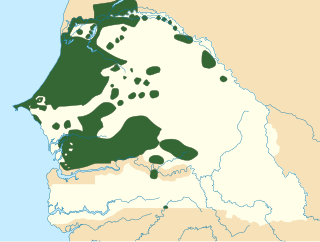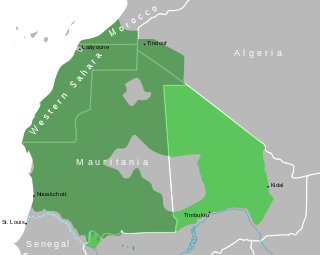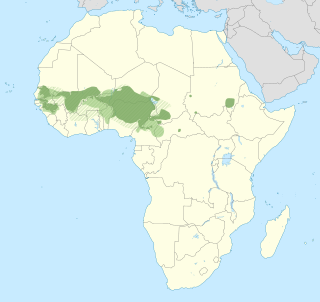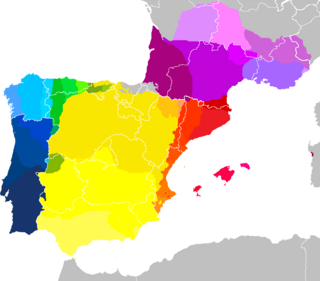
Wolof is a Niger–Congo language spoken by the Wolof people in much of West African subregion of Senegambia that is split between the countries of Senegal, Mauritania, and the Gambia. Like the neighbouring languages Serer and Fula, it belongs to the Senegambian branch of the Niger–Congo language family. Unlike most other languages of its family, Wolof is not a tonal language.

The West Atlantic languages of West Africa are a major subgroup of the Niger–Congo languages.

Hassaniya Arabic is a variety of Maghrebi Arabic spoken by Mauritanian Arabs and the Sahrawi people. It was spoken by the Beni Ḥassān Bedouin tribes of Yemeni origin who extended their authority over most of Mauritania and Morocco's southeastern and Western Sahara between the 15th and 17th centuries. Hassaniya Arabic was the language spoken in the pre-modern region around Chinguetti.
Fang is a Central African language spoken by around 1 million people, most of them in Equatorial Guinea, and northern Gabon, where it is the dominant Bantu language; Fang is also spoken in southern Cameroon, the Republic of the Congo, and small fractions of the islands of São Tomé and Príncipe. It is related to the Bulu and Ewondo languages of southern Cameroon.

The Mandinka language, or Mandingo, is a Mande language spoken by the Mandinka people of Guinea, northern Guinea-Bissau, the Casamance region of Senegal, and in The Gambia where it is one of the principal languages.
The Gusii language is a Bantu language spoken in Kisii and Nyamira counties in Nyanza Kenya, whose headquarters is Kisii Town,. It is spoken natively by 2.2 million people, mostly among the Abagusii. Ekegusii has only two dialects: The Rogoro and Maate dialects. Phonologically, they differ in the articulation of /t/. Most of the variations existing between the two dialects are lexical. The two dialects can refer to the same object or thing using different terms. An example of this is the word for cat. While one dialect calls a cat ekemoni, the other calls it ekebusi. Another illustrating example can be found in the word for sandals. While the Rogoro word for sandals is chidiripasi, the Maate dialect word is chitaratara. Many more lexical differences manifest in the language. The Maate dialect is spoken in Tabaka and Bogirango. Most of the other regions use the Rogoro dialect, which is also the standard dialect of Ekegusii.

Fula, also known as Fulani or Fulah, is a Senegambian language spoken by around 36.8 million people as a set of various dialects in a continuum that stretches across some 18 countries in West and Central Africa. Along with other related languages such as Serer and Wolof, it belongs to the Atlantic geographic group within Niger–Congo, and more specifically to the Senegambian branch. Unlike most Niger-Congo languages, Fula does not have tones.

European Portuguese, also known as Portuguese of Portugal, Iberian Portuguese, and Peninsular Portuguese, refers to the dialects of the Portuguese language spoken in Portugal, Angola, Mozambique, São Tomé and Príncipe and Guinea-Bissau. The word "European" was chosen to avoid the clash of "Portuguese Portuguese" as opposed to Brazilian Portuguese.
Maninka, or more precisely Eastern Maninka, is the name of several closely related languages and dialects of the southeastern Manding subgroup of the Mande language family. It is the mother tongue of the Malinké people in Guinea, where it is spoken by 3.1 million people and is the main language in the Upper Guinea region, and in Mali, where the closely related Bambara is a national language, as well as in Liberia, Senegal, Sierra Leone and Ivory Coast, where it has no official status. It was the language of court and government during the Mali Empire.

Senegal is a multilingual country: Ethnologue lists 36 languages, Wolof being the most widely spoken language.

Pular (𞤆𞤵𞤤𞤢𞤪) is a Fula language spoken primarily by the Fula people of Fouta Djallon, Guinea. It is also spoken in parts of Guinea-Bissau, Sierra Leone, and Senegal. There are a small number of speakers in Mali. Pular is spoken by 4.3 million Guineans, about 55% of the national population. This makes Pular the most widely spoken indigenous language in the country. Substantial numbers of Pular speakers have migrated to other countries in West Africa, notably Senegal.
The Awngi language, in older publications also called Awiya, is a Central Cushitic language spoken by the Awi people, living in Central Gojjam in northwestern Ethiopia.
Kulung is one of the Kiranti languages. It is spoken by an estimated 33,000 people. Van Driem (2001) includes Chukwa as a dialect.

The Balanta are an ethnic group found in Guinea-Bissau, Guinea, Senegal, Cape Verde and The Gambia. They are the largest ethnic group of Guinea-Bissau, representing more than one-quarter of the population. Despite their numbers, they have remained outside the colonial and postcolonial state because of their social organisation. The Balanta can be divided into six clans: Nhacra, Ganja (Mane), Naga, Patch, Sofa and Kentohe. The largest of which are the Balanta Kentohe.

Kaluli is a language spoken in Papua New Guinea. It is a developing language with 3,100 speakers. Some people refer to this language as Bosavi, however the people themselves refer to the language as Kaluli. There are four dialects, Ologo, Kaluli, Walulu, and Kugenesi. The differences between the dialects are not clear. Their writing system uses the Latin script. Kaluli belongs to the Trans-New Guinea language family. Kaluli was first analyzed by Murray Rule in 1964 who wrote a preliminary phonological and morphological analysis. A dictionary of Kaluli has been compiled by Schieffelin and Feld (1998).
Konyak is a Sino-Tibetan language spoken by the Konyak people in the state of Nagaland, north-eastern India.
Bandial (Banjaal), or Eegima (Eegimaa), is a Jola language of the Casamance region of Senegal. The three dialects, Affiniam, Bandial proper, and Elun are divergent, on the border between dialects and distinct languages.
Afenmai (Afemai), Yekhee, or Iyekhe, is an Edoid language spoken in Edo State, Nigeria by Afenmai people. Not all speakers recognize the name Yekhee; some use the district name Etsako.

Ziguinchor is the capital of the Ziguinchor Region, and the chief town of the Casamance area of Senegal, lying at the mouth of the Casamance River. It has a population of over 230,000. It is the seventh largest city of Senegal, but largely separated from the north of the country by The Gambia.

Fuladu or Fuladugu is a historic region and former Fula kingdom in the Upper Casamance, in the south of Senegal, and including certain areas in The Gambia and Guinea-Bissau. It was the last independent pre-colonial state in the area, ceasing to exist in 1903.











